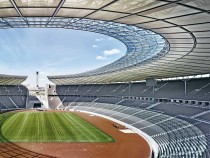
© Heiner Leiska
The football World Cup 2006 has focused international attention once more on the Olympic Stadium in Berlin. Nearly 70 years ago, it stood in the limelight when it was used by the Third Reich as a gigantic stage for propaganda on the occasion of the XIth Olympic Games. After many years of conversion and rehabilitation work, the stadium has now been transformed into a modern arena in which the claims of a venue used exclusively for football, yet with a multifunctional range of activities, have been reconciled sensitively and in accordance with conservation constraints. The most important change is the new roof, which not only alters the spatial mood within the arena, but transforms the entire complex. The lightweight roof construction relativizes the politically motivated heaviness of the stone of the existing stadium, behind which is concealed a remarkably modern (for 1936) reinforced concrete structure. From the underside, within the arena, the roof has a smooth, closed appearance. The clear composition remains legible through the translucent membrane, however. Viewed from the outside, the roof traces a thin line over the existing building, improving its proportions in the process. Some fans may object to the slender columns in the upper tier of stands, but that was the only way of retaining the important urban opening at the Marathon Gate and of expediting the conversion work during an ongoing programme of events in the stadium












